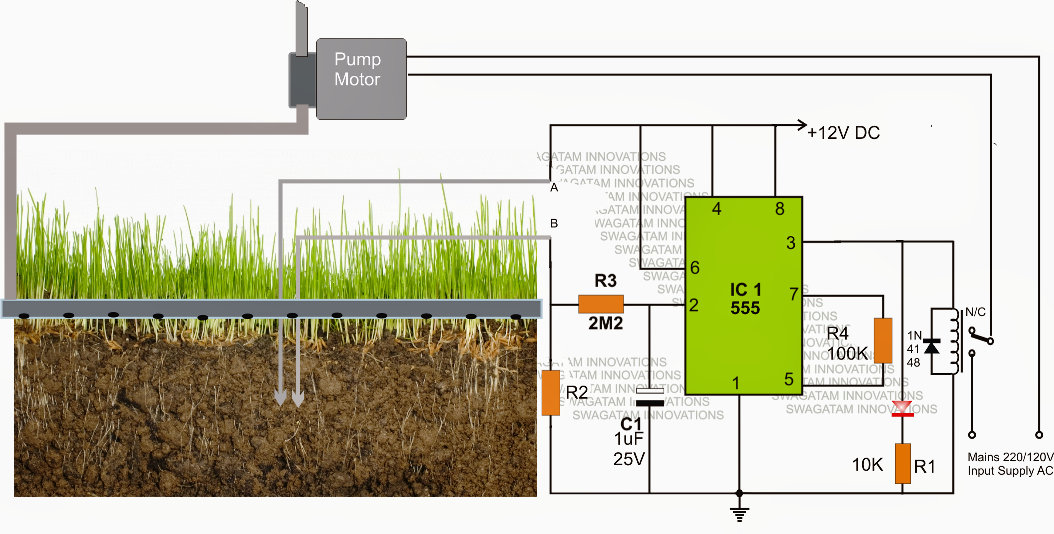The article describes a good automatic plant irrigation system circuit that are available for quickly sensing soil humidity and initiating a water pump when the ground gets burning below a fixed level (adjustable).
The circuit is quite simple and makes use of just one IC 555 as the main active component.
Looking at the automatic plant irrigation circuit demonstrated below we are able to observe the IC 555 is wired in an exclusive and in the fastest feasible mode.
Right here it's designed as a comparator, and functions much better than an opamp simply because the IC 555 has integrated opamps which can be at par with any single opamp as well as the output of a 555 IC has the capacity to sink adequate current to be able to generate a relay without a transistor driver phase.
The above capabilities especially can make the above design quite simple, inexpensive and yet too useful with its features.
The pin#2 right here turns into the sensing pinout of the IC, and is held at ground level via R2 which need to be determined as per the preferred soil humidity activating guideline.
The points A and B may be seen fixed inside the soil which has to be checked for the meant automatic watering from the water pump.
Provided that the points A and B sustains some level of moisture in accordance with a resistance value which might be less than R2, the IC 555 output is held low, which often maintains the relay deactivated.
In spite of this as the soil tends to get dryer, the resistance across the probes begins acquiring higher and at some time of time it gets to be more than R2, producing a potential below 1/3rd supply voltage at pin#2 of IC555.
The above scenario immediately encourages pin#3 of the IC to turn out to be high, initiating the linked relay.
The relay stimulation switches ON the water pump which now commences working water to the specific area of the soil via a publishing water channel.
Since this occur, the soil slowly gets wetter and the moment the specific level is attained, the probes instantly feel the lower resistance and revert the IC ouput pin#3 to a low again changing OFF the relay and the water pump accordingly.
C1 guarantees a slight hysteresis in the procedures making certain the relay activating is not unexpected or sudden, quite it switches only after sensing an original reply from the soil situations.

The above stated automatic plant irrigation circuit was effectively developed and analyzed and the
following pictures display the prototype unit and the PCB design.


Hi sir can I get this x inverter with 1c 555
board on shops
Hi Rohith, this is not an inverter circuit, do you mean the plant watering board?
Hiii sir your project is superb . I want to go this project, I’m doing mini project may I connect the small DC motor to run the same operation could you plzzz tell me sir
Hi Raju, yes you can connect a small DC motor with the relay contacts by configuring DC supply with the relay….
can you tell us all the components used in the circuit
part numbers are given in the diagram, you can note it on paper and show it to the shopkeeper he will assist you
all the resistors are 1/4 watt
R2 can be a 1M pot, relay can be a 12V 400 ohm relay
we need circuit diagram and its working and is there a video of how this system works??
video is not there at the moment, but the circuit definitely work, no doubt about it
Dear
The resistance R2 can be replaced by a variable resistance to determine the level of soil moisture
Thank you
yes that’s possible and is recommended